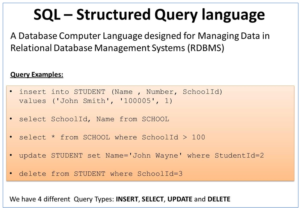Introduction to SQL
SQL (Structured Query Language) is a database computer language designed for managing data in relational database management systems (RDBMS).
SQL, is a standardized computer language that was originally developed by IBM for querying, altering and defining relational databases, using declarative statements.
SQL is pronounced /ˌ𝖼s kjuː ˈ𝖼l/ (letter by letter) or /ˈsiːkwəl/ (as a word).

What can SQL do?
- SQL can execute queries against a database
- SQL can retrieve data from a database
- SQL can insert records in a database
- SQL can update records in a database
- SQL can delete records from a database
- SQL can create new databases
- SQL can create new tables in a database
- SQL can create stored procedures in a database
- SQL can create views in a database
- SQL can set permissions on tables, procedures, and views.
Even if SQL is a standard, many of the database systems that exist today implement their own version of the SQL language. In this document, we will use the Microsoft SQL Server as an example.
There are lots of different database systems, or DBMS – Database Management Systems, such as:
- Microsoft SQL Server
- Enterprise, Developer versions,
- Express version is free of charge
- Oracle
- MySQL (Oracle, previously Sun Microsystems) – MySQL can be used free of charge (open source license), Web sites that use MySQL: YouTube, Wikipedia, Facebook
- Microsoft Access
- IBM DB2
- Sybase
- … lots of other systems

In this Tutorial, we will focus on Microsoft SQL Server. SQL Server uses T-SQL (Transact-SQL). T-SQL is Microsoft’s proprietary extension to SQL. T-SQL is very similar to standard SQL, but in addition it supports some extra functionality, built-in functions, etc.
Other useful Tutorials about databases:
- Introduction to Database Systems
- Database Communication in LabVIEW
These Tutorials are located at: https://www.halvorsen.blog